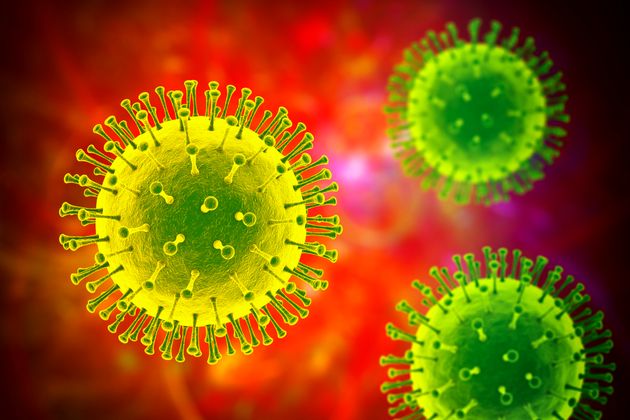Part of the virus that causes the illness Covid-19 could be used to help relieve pain, a new study suggests, by blocking the body’s pain pathway at a cellular level.
Scientists believe the finding, initially discovered in rats, could help pave the way for new pain treatments in the future, and might also go some way in explaining why those who are newly infected with the virus don’t initially feel symptoms.
So, what do you need to know?
How can the virus switch off pain?
Now, this is the science-y bit. Viruses infect your body’s host cells through protein receptors, which are found on the cells’ membranes. Early in the pandemic, scientists established that the SARS-CoV-2 spike protein uses an enzyme called ACE2 to enter the body.
But in June, pre-print studies pointed to a protein called neuropilin-1 as another possible way for the virus to enter and then infect the body.
Lots of biological pathways signal the body to feel pain. One is through a protein known as VEGF-A. It plays an essential role in blood vessel growth, but has also been linked to diseases such as cancer, rheumatoid arthritis and Covid-19.
When the body is negatively affected by external stimuli (for example, a person hurts themselves) or is exposed to an infection, VEGF-A binds to the protein neuropilin in the body – and it initiates a cascade of events which, researchers say, results in you feeling pain.

Rajesh Khanna, a professor in the College of Medicine at the University of Arizona Health Sciences, and his research team found that the SARS-CoV-2 spike protein binds to neuropilin in exactly the same location as VEGF-A.
They performed a series of experiments in the laboratory and in rodents to see whether the spike protein disrupts the VEGF-A/neuropilin pain pathway – and therefore stops pain.
They used VEGF-A as a trigger to induce pain, and then sent in the SARS-CoV-2 spike protein. The spike “completely reversed” the VEGF-induced pain signalling, says Prof Khanna, of the study in rats. “It didn’t matter if we used very high doses of spike or extremely low doses – it reversed the pain completely.”
It reversed the pain completely.

There are some questions left unanswered by the research, though. For example: what types of pain could this help relieve? “Our data shows reversal of injury induced pain in rats,” Khanna tells HuffPost UK. “This injury models a form of neuropathic (persistent) pain.”
Whether the spike protein can reverse other kinds of pain – such as arthritic, cancer-induced, inflammation or surgical pain – is too early to tell, he adds.
“But we are currently investigating targeting of neuropilin-1, the new target of pain revealed by our current study, for potential utility for developing a new class of anti-pain drugs.”
What has this got to do with the spread of Covid-19?
Prof Khanna says the finding might go some way in explaining why so many people who get Covid experience few or no symptoms – even though they are able to spread the disease. While we don’t know exactly how many people tend to have Covid-19 without symptoms, we do know that the number could range from 20-50% of those who get infected.
“It made a lot of sense to me that perhaps the reason for the unrelenting spread of Covid-19 is that in the early stages, you’re walking around all fine as if nothing is wrong because your pain has been suppressed,” says Prof Khanna of his theory.
“You have the virus, but you don’t feel bad because your pain is gone. If we can prove that this pain relief is what is causing Covid-19 to spread further, that’s of enormous value.”
But, why do some people still experience pain with Covid-19?
It’s not yet clear. “A limitation in our study is that while we looked at the effect of Spike directly on pain, patients also develop an immune response neutralising the virus,” says Prof Khanna. “We did not test if this happened in our rats.
“We have anecdotal evidence from chronic pain patients emailing us reporting that their pain is gone when they contracted Covid.”
Dr Julian Tang, honorary associate professor and a clinical virologist in the field of Respiratory Sciences at University of Leicester, calls the findings “intriguing”. “We already know some Covid-19 patients can develop neurological and neuropsychiatric complications, demonstrating that SARS-CoV-2 – the virus causing Covid-19 – is also neurotropic [meaning it can infect the brain],” he said.
There is some further way to go before this becomes a practical drug intervention for pain control.Dr Julian Tang
But there are limitations to the research. “This team has only looked at this in laboratory and rat models so far, so although the enticing video on their website shows possible potential in humans, there is some further way to go before this becomes a practical drug intervention for pain control,” Dr Tang continued.
“Also, given the complexity of the human immune response to the infection, not all patients with Covid-19 are necessarily free of pain, as we have seen.
“But as the team say, this SARS-CoV-2 S protein interaction has stimulated them to look at neuropilin-1 as an alternative pain receptor to block to provide pain relief without the use of potentially addictive opioids, like morphine – which work on a different pathway.
“With Covid-19 causing so much grief and distress globally, it is possible that this finding has offered at least a thin silver lining in this pandemic.”
Dr Khanna hopes to continue research into the role of neuropilin in the spread of Covid-19 and plans to examine it as a new target for non-opioid pain relief, too.
“We have a pandemic, and we have an opioid epidemic,” says Dr Khanna. “They’re colliding. Our findings have massive implications for both. SARS-CoV-2 is teaching us about viral spread, but Covid-19 has us also looking at neuropilin as a new non-opioid method to fight the opioid epidemic.”



